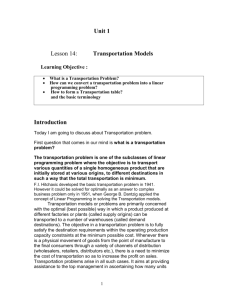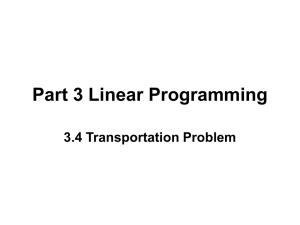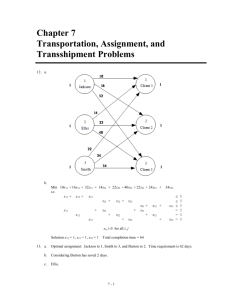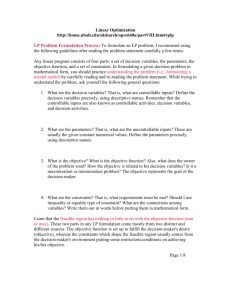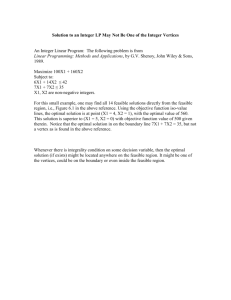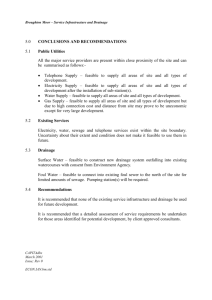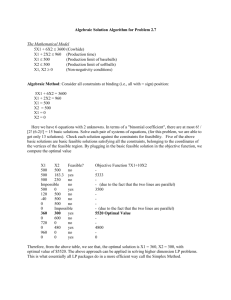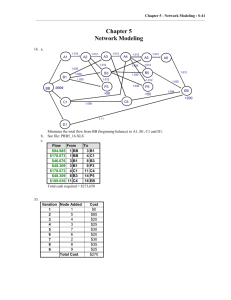Transportation Problem: North-West & Matrix Minima Methods
advertisement
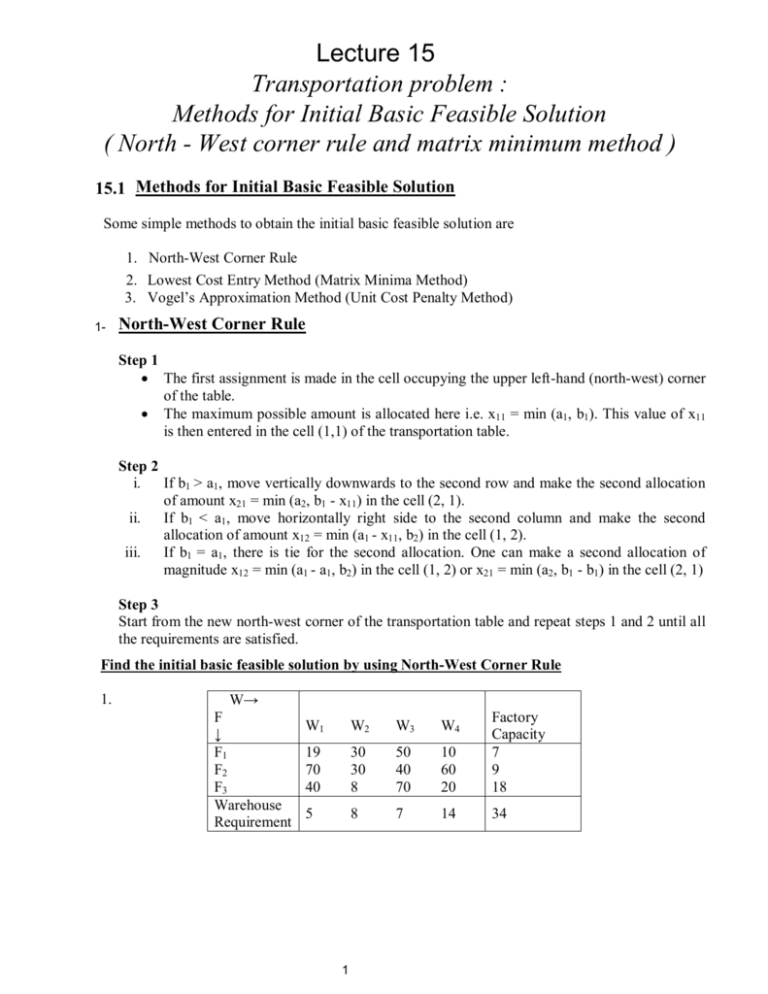
Lecture 15 Transportation problem : Methods for Initial Basic Feasible Solution ( North - West corner rule and matrix minimum method ) 15.1 Methods for Initial Basic Feasible Solution Some simple methods to obtain the initial basic feasible solution are 1. North-West Corner Rule 2. Lowest Cost Entry Method (Matrix Minima Method) 3. Vogel’s Approximation Method (Unit Cost Penalty Method) 1- North-West Corner Rule Step 1 The first assignment is made in the cell occupying the upper left-hand (north-west) corner of the table. The maximum possible amount is allocated here i.e. x11 = min (a1, b1). This value of x11 is then entered in the cell (1,1) of the transportation table. Step 2 i. If b1 > a1, move vertically downwards to the second row and make the second allocation of amount x21 = min (a2, b1 - x11) in the cell (2, 1). ii. If b1 < a1, move horizontally right side to the second column and make the second allocation of amount x12 = min (a1 - x11, b2) in the cell (1, 2). iii. If b1 = a1, there is tie for the second allocation. One can make a second allocation of magnitude x12 = min (a1 - a1, b2) in the cell (1, 2) or x21 = min (a2, b1 - b1) in the cell (2, 1) Step 3 Start from the new north-west corner of the transportation table and repeat steps 1 and 2 until all the requirements are satisfied. Find the initial basic feasible solution by using North-West Corner Rule 1. W→ F ↓ F1 F2 F3 Warehouse Requirement W1 W2 W3 W4 19 70 40 30 30 8 50 40 70 10 60 20 Factory Capacity 7 9 18 5 8 7 14 34 1 Solution F1 W1 W2 5 2 (19) W5 3 (30) (40) 4 F3 14 (70) 5 Requirement 0 Availability (30) 6 F2 W3 8 6 0 7 4 0 (20) 7 2 0 9 3 0 18 14 0 14 0 Initial Basic Feasible Solution x11 = 5, x12 = 2, x22 = 6, x23 = 3, x33 = 4, x34 = 14 The transportation cost is 5 (19) + 2 (30) + 6 (30) + 3 (40) + 4 (70) + 14 (20) = Rs. 1015 2. O1 O2 O3 O4 Demand D1 1 3 0 2 21 D2 5 3 2 7 25 D3 3 1 2 2 17 D4 3 2 3 4 17 Supply 34 15 12 19 80 D4 Supply Solution D1 D2 D3 21 13 O1 (1) (5) 12 3 O2 (3) (1) 12 O3 (2) 2 O4 (2) Demand 21 25 17 0 12 14 0 2 0 34 13 0 15 3 0 12 0 17 (4) 19 17 0 2 17 Initial Basic Feasible Solution x11 = 21, x12 = 13, x22 = 12, x23 = 3, x33 = 12, x43 = 2, x44 = 17 The transportation cost is 21 (1) + 13 (5) + 12 (3) + 3 (1) + 12 (2) + 2 (2) + 17 (4) = Rs. 221 3. From To 2 1 3 Demand 3 11 4 1 10 7 4 3 2 8 7 1 12 3 4 5 6 Supply 4 8 9 Solution From To 3 1 (2) (11) 2 4 2 (4) (7) (2) 3 6 (8) (12) 3 3 4 5 6 Demand 0 2 0 3 0 0 0 Supply 4 1 0 8 6 2 0 9 6 0 Initial Basic Feasible Solution x11 = 3, x12 = 1, x22 = 2, x23 = 4, x24 = 2, x34 = 3, x35 = 6 The transportation cost is 3 (2) + 1 (11) + 2 (4) + 4 (7) + 2 (2) + 3 (8) + 6 (12) = Rs. 153 3 2- Lowest Cost Entry Method (Matrix Minima Method) Step 1 Determine the smallest cost in the cost matrix of the transportation table. Allocate xij = min (ai, bj) in the cell (i, j) Step 2 If xij = ai, cross out the ith row of the table and decrease bj by ai. Go to step 3. If xij = bj, cross out the jth column of the table and decrease ai by bj. Go to step 3. If xij = ai = bj, cross out the ith row or jth column but not both. Step 3 Repeat steps 1 and 2 for the resulting reduced transportation table until all the requirements are satisfied. Whenever the minimum cost is not unique, make an arbitrary choice among the minima. Find the initial basic feasible solution using Matrix Minima method 1. F1 F2 F3 Requirement W1 19 70 40 5 W2 30 30 8 8 W3 50 40 70 7 W4 10 60 20 14 4 Availability 7 9 18 Solution F1 F2 W1 W2 W3 W4 (19) (30) (50) (10) (70) (30) 8 (8) X (40) (60) (70) 7 (20) 14 W1 W2 W3 (19) (30) (50) W4 7 (10) (70) (30) 8 (8) X (40) (60) (70) 7 (20) 7 F3 (40) 5 F1 F2 F3 F1 F2 F3 F1 F2 F3 (40) 5 9 10 W1 W2 W3 (19) (30) (50) (70) (30) 8 (8) X (40) (40) 5 7 (70) 7 W1 W2 W3 (19) (30) (50) (70) 3 (40) 2 (30) 8 (8) X (40) (70) 7 X 9 10 W4 7 (10) X 9 (60) 7 (20) X W4 7 (10) (60) 7 (20) X 3 X 9 X 5 F1 F2 F3 W1 W2 W3 (19) 2 (70) 3 (40) X (30) (50) 7 (40) (30) 8 (8) X (70) X W4 7 (10) X X (60) 7 (20) X X Initial Basic Feasible Solution x14 = 7, x21 = 2, x23 = 7, x31 = 3, x32 = 8, x34 = 7 The transportation cost is 7 (10) + 2 (70) + 7 (40) + 3 (40) + 8 (8) + 7 (20) = Rs. 814 2. 2 1 3 3 From Requirement To 11 4 9 3 10 7 4 4 3 2 8 5 7 1 12 6 Availability 4 8 9 Solution To 4 (3) From 3 (1) 3 0 3 (9) 3 0 4 (4) 4 0 1 (8) 5 1 0 4 0 5 (1) 1 (12) 6 1 0 8 5 0 9 5 4 1 0 Initial Basic Feasible Solution x14 = 4, x21 = 3, x25 = 5, x32 = 3, x33 = 4, x34 = 1, x35 = 1 The transportation cost is 4 (3) + 3 (1) + 5(1) + 3 (9) + 4 (4) + 1 (8) + 1 (12) = Rs. 78 6
